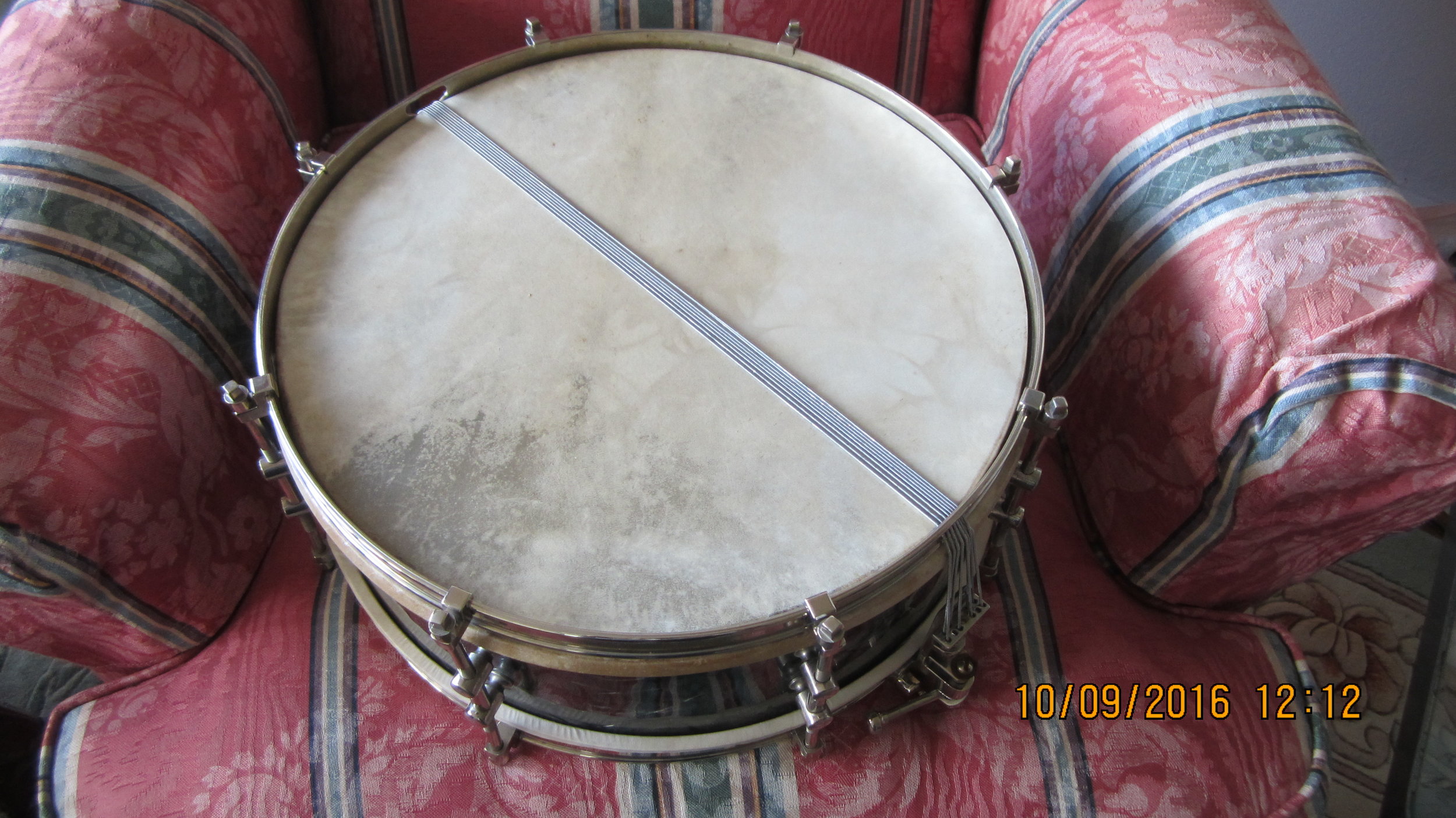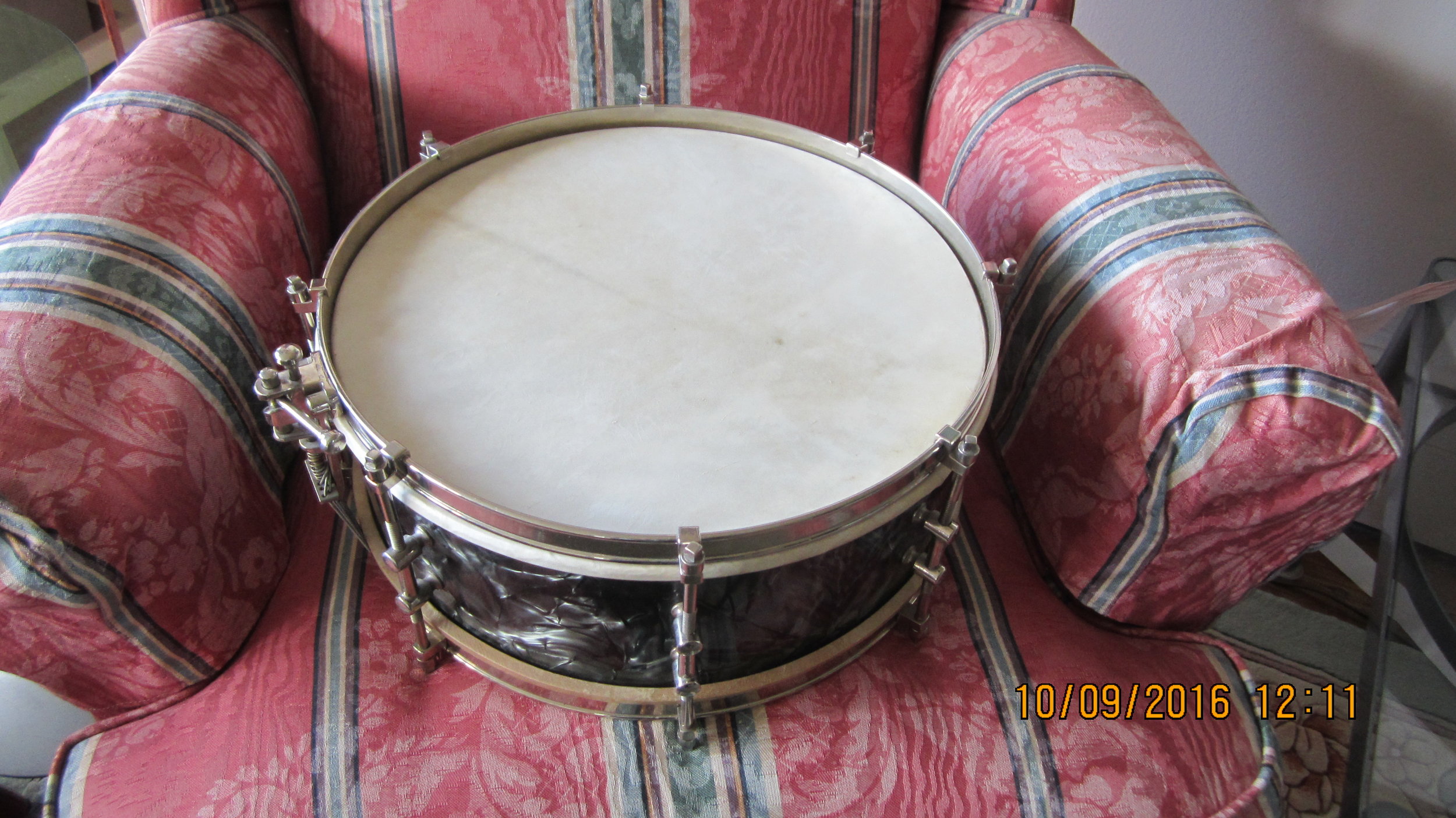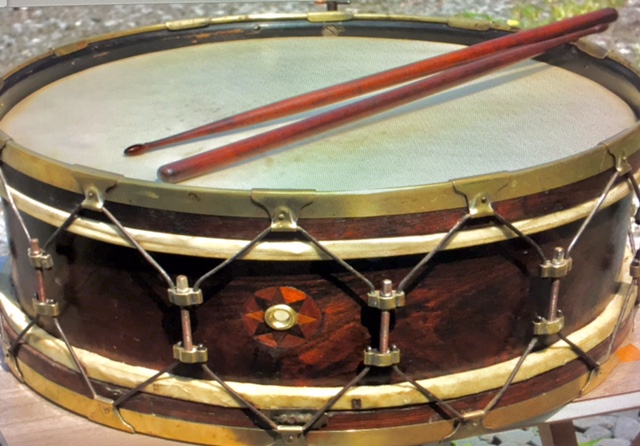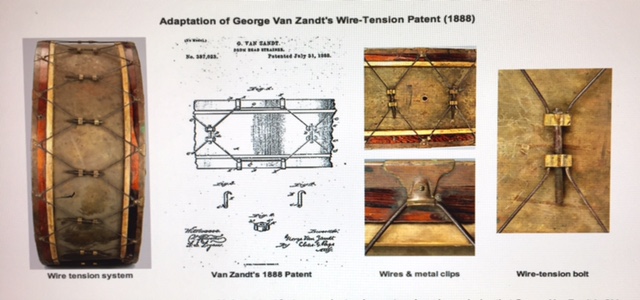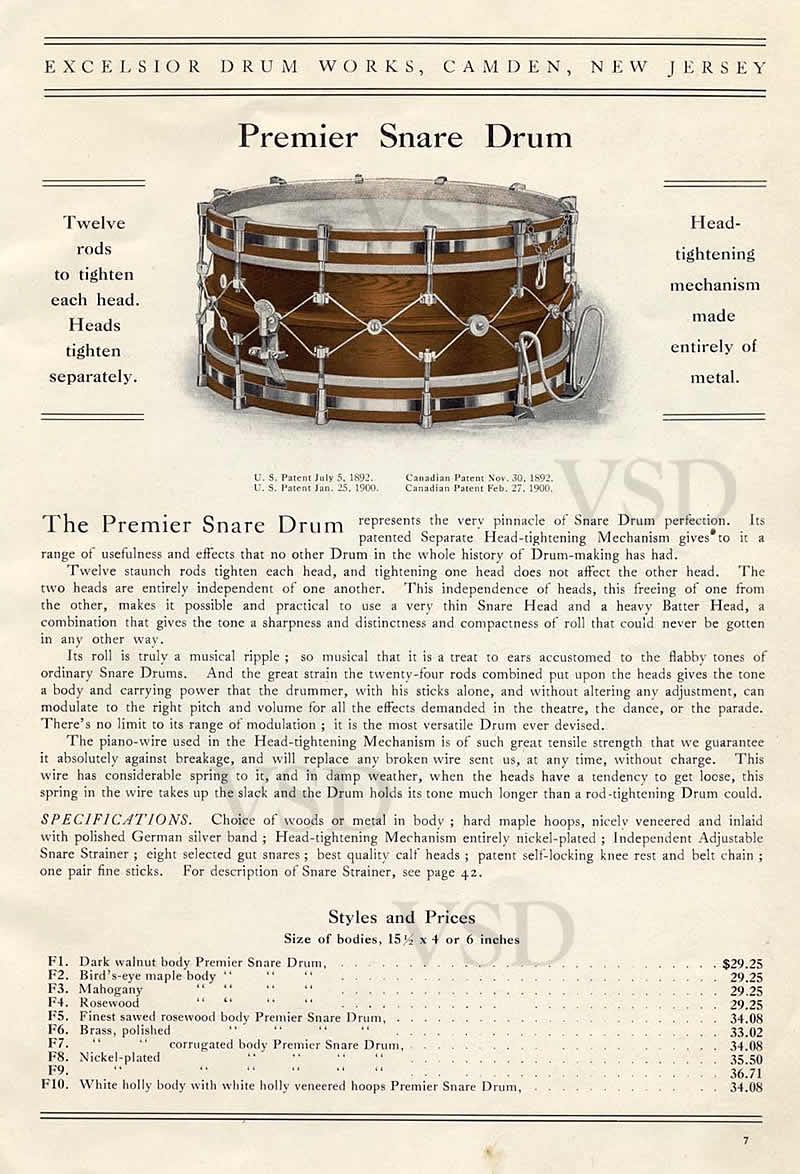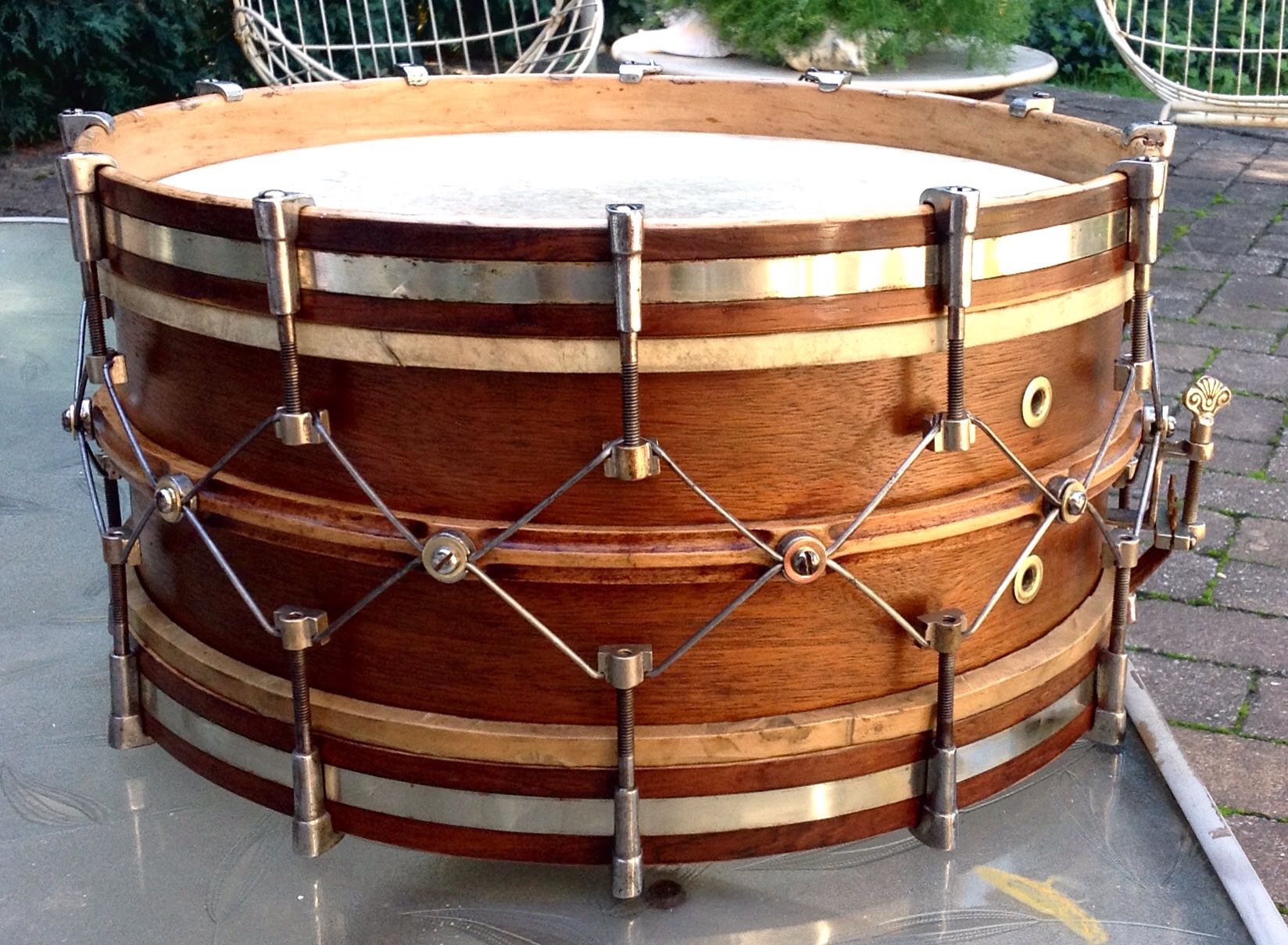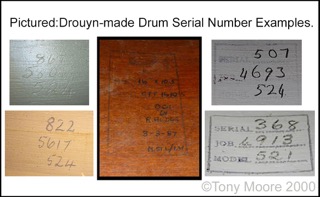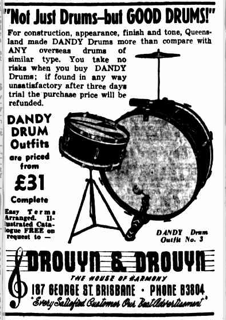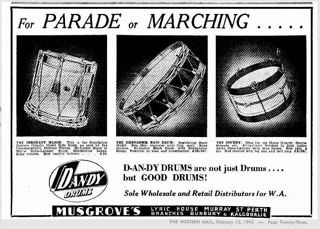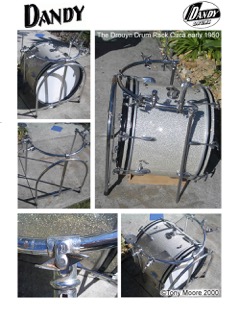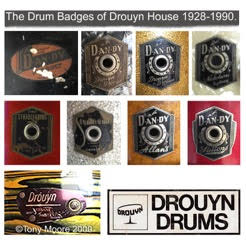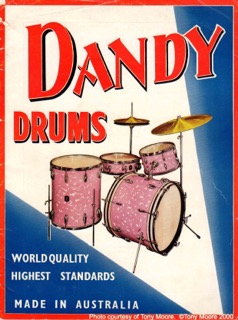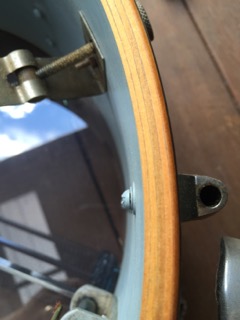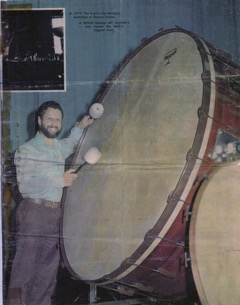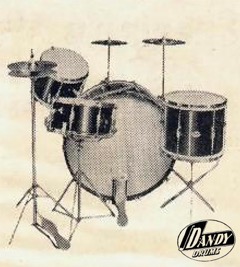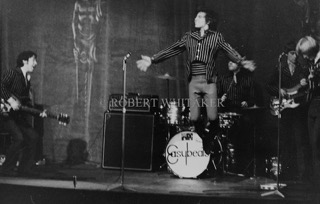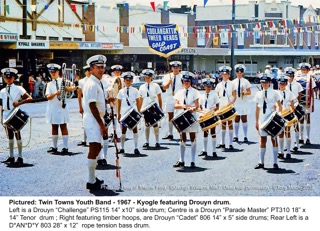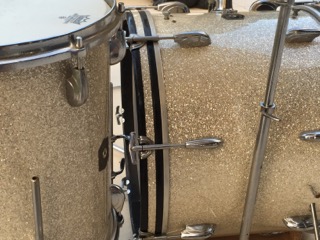??????????????????????????????????
Read moreMemphis Drum Shop
Nestled in the heart of Midtown Memphis, located in the ever popular Cooper-Young district, there is a special place with deep ties to music. With its flat white exterior, and black awning, 878 S. Cooper Street is home to none other than the world famous Memphis Drum Shop.
Read moreTruss Tension Drums
The late 1880s – 1900s was what was known as the “transition” period for snare drums and drums in general. This was the transition from rope tension to metal rod tension. It originated from the European or “Prussian“ designed drums consisting of sometimes highly decorated wood hoops over a metal shell. Metal hooks and long te
Read moreMystery: What drum shop does Frank Zappa's "Drum Shop" art collage depict?
An episode of the series "History Detectives" featuring Cal Schenkel, Bobby and Gail Zappa investigating whether a Collage painting is or isn't by Frank Zappa. Original broadcast hosted on video.pbs.org/video/2253617192
In addition to being the musical genius and political dissident that we all know, Frank was also an artist (and a drummer). One particular piece he created was lost then found and an investigation by PBS turned up some surprising ties to the drum shop world.
Read moreAndy White's Beatles drum set
This is the 1956 mahogany shell Ludwig Super Classic finished in black diamond pearl that was used by Andy White on the very first Beatles record
Read moreJasper Wood - Gretsch's standard 6 ply shells and Centennial shells
The company Jasper Wood closed down in 2003. Because they had been primarily an office-furniture manufacturer they were forced out of business by the importation of cheap products… we’re all guilty here!
Read moreBilly Ward - Journey of the Group
Any words of advice for players who are pursuing a life in music? "I'm happy you said "life in music" as opposed to "career in music". I think careers in music have lessened - but interaction with youtube and such websites has made it easier to communicate. People can make a record in their home now! My only advice is to do it because you HAVE to and can't live without it. If somebody does it for fame and fortune they will be sorely disappointed. Be as best a musician as possible - study MUSIC, not just drumming.
Read moreVic Firth - An American Classic - My Tribute To The Man Who Touched My Life
"What you leave behind in not what is engraved in stone monuments, but what is woven into the lives of others." ~ Pericles
Read moreWe come from the land down under - Australia’s Drouyn & Drouyn Drum Company (1928-1990)
by Tony Moore
When we think of vintage or classic drums, great drum makers, innovators, pioneering drum companies - those giants of our drum history, the founders of the inheritance that we now enjoy, those innovations and the men and women who made them - only a handful of people would know to include Australia's Drouyn & Drouyn drum company. Even less would know of their chief designer, engineer, innovator and drum maker, the great George Meacham.
For this, my first article for Not-so Modern Drummer, I'd like to introduce or reintroduce many of you to Australia's first drum manufacturer, the much loved Drouyn & Co. Drum Company, fondly known simply as ‘Drouyn’.
Midnight oil, The Easy Beats, The Penny Rockets, The Jonny O’Keefe band, Max Merritt and The Meteors, Billy Thorpe, Stevie Wright, Kings of the Sun, Skyhooks, Matt Finish and numerous other Australian bands and artists know of that world-class quality and unique sound. Freddie Strauks, Rob Hirst, Johnny Dick, Clifford Hoad and Drouyn’s official endorsees such as: Bobby Bell, Vincent ‘Nutty’ Cook, Bob Forman, Des McCreath, Tommy O’Connor, John Osborne, Tommy Spencer, Barry Sutton, Max Sweeney, The Shaws Band, Bob Watson, Neil Wilkinson and Al Vincer, all knew that DANDY magic.
Not a drum in sight [well almost]
Drouyn and Drouyn were first founded in 1927 with the signing of a tenancy agreement by sibling musicians Douglas (Doug) and Dorothy Drouyn, who subsequently opened a small music store situated at 187 George Street Brisbane City Australia. Both Doug and Dorothy were avid performers and with growing social status and rapport from playing in dance band concert halls, ballrooms, including Brisbane’s famous Cloudland in the forties, and their appearance on local Radio station 4BK. They quickly established a regular clientele who valued their currency of style, quality, satisfaction and trust.
Commencing business in 1929, originally selling basic music supplies, music books and orchestra music, they quickly moved into drum repairs, importing drums and quality temple blocks, as well as manufacturing custom piano accordion and guitar cases. Doug, an accomplished saxophonist, saw a market and quickly diversified into selling woodwind and other instruments, providing customers in-house servicing and repairs.
By the early1930s Drouyn's expanding business included other products, services and sales - notably Ludwig drums and banjos, National Silver guitars, Paolo Soprani, Rita Livio and Adamo piano accordians, Bulscher saxophones and trumpets, Boehm and 'D Noblet (Paris) Clarinets - winning a publicized 'First Order of Merit Award' at the 1930s Royal National Show for their musical instruments display.
A distinguished man of principle, Douglas Lewis Drouyn felt that treating people respectfully deserved his personal guarantee.
Introducing George Meacham
By 1935 Drouyn and Drouyn had become Australia’s largest stockist of Accordions. The masterstroke came when Douglas Drouyn hired all-round, inventor, engineer, manufacturer, designer and friend, Mr George Meacham.
George started with Drouyn and Drouyn in 1937, and I’m certain that Drouyn drums would never have been if it was not for this brilliant, servant-like and humble man. He lovingly serviced client’s instruments, repaired broken bits and manufactured things that just didn’t exist. During the early formative years, George’s talents for everything pioneered the Drouyn and Drouyn Music House, right down the pathway towards manufacturing. With the addition of George and other key- staff, such as Maurice Hinds - who joined in 1943 - Doug had assembled a team with the skills and desire to create, copy and innovate.
Drouyn’s Music House had fast become the go-to experts in musical instrument repairs, and Australia’s premier instrument repairer, servicing military instruments and imported drums such as Leedy, Slingerland, Noble and Cooley, early Ludwig etc. For many years Drouyn‘s would carve out a specialty musical instruments sales and repair business that expanded to custom case manufacture, in-house parade drum manufacture, instrument modifications and an expanding new musical instruments catalogue.
This period repairing other manufacturers drums was essential in providing George and his team the skills, know-how and confidence to step into the drum manufacturing market. The early Drouyn-made drums were mostly military or elementary school parade drums, of which known examples clearly demonstrate the chain of improvements and advances that led to later models, advances and successes.
Building the Brand
Soon business began to expand nationally, attracting and pursuing distribution agreements for Dandy drums, building beneficial retail and distributor relationships and uncovering fresh opportunities to expand and open into new markets.
A good example of Doug’s business-savvy acumen and far-reach is evidenced in how his distributers supported the DANDY brand in their advertising. Shown is an ad published in a Western Australia newspaper in February 1942, for the musical instruments wholesalers and distributers - this advertisement features three Dandy parade drums: The Sergeant Major (14” x 14”); The Grenadier (28” x 11”); and The Sturdy (14” x 6”). All of which became a staple of their manufacture.
Paper Badge Drums and that D.AN.DY name
The Musgrove’s advertisement provides the first of two clues that identify distinct periods of Drouyn’s drum making. The obvious clue I have called Drouyn's 'paper badge' drums. Drouyn's 'Paper Badge' drums represent a period of Drouyn’s history between the late 30's and late 40’s/ early 50's, where Drouyn first intentionally branded and marketed a range of drums which they fondly named D.AN.DY.
The brand name DANDY is actually a partial acronym, which can be first observed from the subtle full stops between the first 'D' and A, and also the 'N' and second 'D'. The first 'D' is short for Doug and the second D is short for Dorothy; the 'AN' is an abbreviated inference for 'and' - as-in Doug and Dorothy – with the 'Y' complementing the early 1900's expressions and meanings of the word 'dandy' as being stylish and fashionable, or "an excellent thing of its kind".
The second clue, is inferred or deducted from the first. I have on record or archive the details of hundreds of Drouyn made drums, collected over 30 years, which testify and highlight the many very-early drums made by Drouyn, which had no badges (not even paper ones). They had no numbers or date-related markings, or other intentional identifiers of their age. These drums were early forms or developmental variations of the later DANDY paper badge drum shell, hoop, tension systems and lug designs. Pre paper badge drums cannot normally be dated specifically, but otherwise grouped into a date range and then within this range, ranked in order of early versions to later ones based on known manufacturing changes and advances or modifications to the drum line.
Numbering, or serial numbers came later for Drouyn. As manufacturing transitioned from ad hoc or demand based to more intentional marketed drum manufacturing, these processes required serial numbers for tracking through the manufacturing process and also for department stores and retailers to receive and stock take Dandy items.
In brief, both the pre-paper badge and the paper badge drums were often made from a new (at the time) product called masonite. Masonite is a reconstituted fibrous hardwood sheet-based product, which 50 years later would be used by Premier in their XPK kits. Ironically, Masonite, like Remo’s Acousticon, has great acoustic properties and adds both economical and tonal value to it use.
These early Drouyn masonite drums were generally fitted with steam bent reinforcement rings of varying local timbers and utilized a rope and tag, or DIY styled post and rail lug tension systems, or hoop to hoop tuning. These systems and tension assemblies were very similar to Leedy's drums of that period. All drums had steam bent wood hoops, and in house fabricated brass soldered metal components which were nickel plated and fastened with off the shelf whitworth fasteners and washers.
The shell finish was a hand painted finish, similar to enamel paint with the hoops more ornate or regal in appearance. A paper badge was fixed with glue and shellacked over to finish. Drums were fitted with calf or kangaroo skin heads, lapped in house and tuned prior to dispatch.
Drouyn's pre-paper badge history is extensive and difficult to excavate. Their paper-badge history was relatively short, for with increasing sales and growth came opportunities to build purpose built machinery and add other touches such as brass name plates.
The Roaring Forties - When the Drums Began to Bloom
This period from the mid 1940s and to the late 1950s marks a point in Drouyn's history where Drouyn & Drouyn's Music House transitioned from musical instrument servicing, piano tuning and repairs, retailer - of even radios - to drum products manufacturing giant.
One advertisement states: “Not Just Drums-but GOOD DRUMS!”.
It highlights their growth and advancement from earlier paper-badge drum tensioning systems to something more intentional. In doing this, Doug and Dorothy nailed their flag to the mast and said:
WE MAKE DRUMS - GOOD DRUMS
It was this intentional focus that would open the next door towards success.
A Drum - by another name - is still a Drouyn: Allans, Suttons, DANDY, Stradivarius, Nicholson and Drouyn.
As exclusive Australian importers and distributers of many musical products, Doug and Dorothy had developed supply channels with Australia’s retail giants, such as:
- Australia’s oldest music retailer Allans Music – Melbourne Victoria established in 1850 by Joseph Wilkie and George Allan;
- Suttons Music Store - Ballarat Victoria, established in 1884 by Alfred Sutton;
- The Stradivarius Instrument Co. - Adelaide, South Australia; and
- Nicholson & Co. - Melbourne, Sydney, Brisbane & Perth, which was established in 1878. Drouyn’s reputation for quality and sound, had established DANDY drums as a clear leader.
With a solid product and increasing demand and respect from drummers, these major retailers and speciality musical instrument suppliers commissioned Drouyn and Drouyn to manufacture DANDY drums under their own respective trading names and brand.
Pictured are nine of the known badges that Drouyn & Co. manufactured under. So with much badge confusion, it had been a long held puzzle how these different brands fit into the Drouyn story - if they were related or belonged at all.
In brief, all of the above drums, regardless of badge, were identical in manufacture, both inside and out, with only the badge changing. This was a great business concept because with every Drouyn made drum sold, regardless of the badge, their lug design, sound and classic look built the brand name Drouyn & Drouyn.
So yes! the numbers have it, all nine of the drums pictured were manufactured by Drouyn between 1929 and 1990, including the pre-paper badge or badgeless drums.
Drouyn's Serial Numbers Theory. Do the numbers have it?
There are many mysteries, beliefs and theories about Drouyn drums. It appears that whenever there is an absence of information, we tend to want to fill it with a story or try to make sense of it. Instead of just letting the drums speak for themselves we tend to speak on their behalf. I have been researching, gathering and analysing this material over the last twenty years, and the drums are beginning to speak.
With out giving the plot away, the numbers (from top to bottom) simply mean: Serial, Job and Model. The most popular belief, is that the first two numbers of the Job number, which is the middle set of numbers, reflects the year of manufacture. So, 5801 would be manufactured in 1958; the 5617 would be 1956; and so on.
Records indicate that Drouyn used the same stamping system from the 1950s until the 1980s, when a new stamp was suddenly introduced. Shown is the stamp of a drum made in March 1987, which was only 23 months before Drouyn and Co. was deregistered. You can see that a new stamp was used, and has the following titles under the 1965 Drouyn snare drum and stand logo at top:
• SIZE • MODEL • SERIAL No • VENEER • DATE • OFFICIALS (though not sure)
It is a cue, although subtle, which indicates indecisiveness and a lack of the same confidence that saw Drouyn drums roaring in the forties, flying in the fifties and swing in the early sixties. Late adoption of new manufacturing systems, few new products or product advancements, poor management and no succession plan to replace the aging and retiring highly experienced drum makers was uncharacteristically Drouyn. This gives clue to factors that will later prove to be the determinants that lead to the slow drawn out death of the Drouyn & Co. But first, let’s celebrate the swinging sixties.
All Systems are Go!
The early sixties marked a great year in Drouyn’s history. Following the loss of his much loved sister Dorothy in 1954, Doug took some time to refocus. The success of the Dandy paper-badge drums in the 40s and early 50s had given Doug the means to grow the business, to change with the times and seek out new opportunities.
The establishment of Drouyn House, aka the Drouyn Drum Factory, at 382 Logan Rd, Stones Corner Queensland was the most significant investment in success as it gave the Drouyn team the ability to make high quality drums more efficiently. The tightly packed factory was a hive of manufacturing and production activities as this Australian Drum Making marketing depicts.
Steered by the guarantee of Doug and Dorothy in the early days - their business brand DANDY, was always built on style, world-class quality and sound, but also the belief that “...every satisfied customer, is our best advertisement.”
In 1958, Drouyn & Co. Pty Ltd. was registered as a company - a decision that would prove essential to secure later lucrative government contracts - and saw the way forward. From the mid 50s the brass plate DANDY drums had carved a niche and proved world class by famous Australian drumming greats and visiting drummers. So it was time for Drouyn to declare it and to let the world know about DANDY drums.
In 1960, Drouyn and Drouyn released their DANDY DRUMS catalogue, a twenty page catalogue featuring four snare drum models, four bass drum models, nine floor tom and tom tom, models including timbales, concert toms and bongos, thirty eight accessories and hardware items, all made in-house.
What is most remarkable about Drouyn’s DANDY drums catalogue, is that almost 98% of these items were made within the four walls of their Stones Corner factory. Vellums were lapped, lugs cast, hardware made, tension rods, fittings, stands, snare wires, pedals, springs, hoops, wood blocks, claves, felts - almost everything was manufactured in house, with chromium and raw material such as veneers, metal and vellums, being the only few items and/or processes outsourced. This would be a feat that, todays custom drum builders would be hard pressed to achieve even with all the technological advances and ease of manufacture. Back in the 50s, it all had to be invented.
Their retail success, service, quality and respected prominence on the music and military scenes, particularly with the success and growth of their school and parade drum programs positioned Drouyn & Co for some very big achievements.
The world’s most expensive drums: RAN Silver Drums
Drouyn’s peak achievement, both personally for George and Drouyn as a business, was in 1958 with the commissioning by the Australian Federal Government to manufacture the world’s most expensive drums made entirely from solid sterling silver.
This commission was to commemorate the Royal Australian Navy’s 50th anniversary on 10 July,1961. Each drum, on completion, was presented to their respective States and Territories from December 1963. Their first collective official appearance was at The British Military Tournament and Tattoo, Sydney Show grounds during September and October 1964. These drums, including the badges, lugs, hoops, tension rods, washers, screws, snare mechanisms and claws and T-rods are all solid silver. Valued at over 1.5 million dollars, the world’s most expensive set of drums are encased for public display, housed in a secured purpose built display cabinet on a fortified Naval facility on an island in Sydney harbour.
The new Era: Simply ‘Drouyn’
It was almost as if Doug knew that Drouyn drums were going to be a big deal when he made it into a company in 1958. The 60s saw massive growth and accomplishment, with the increasing sales, revenues and fame, all made possible by their premises in Stone Corner, affectionately know as ‘the Factory’ .It was other wise officially known as ‘Drouyn House’.
Following Doug’s death in 1964, a complete badge change occurred, the badge I call their ‘tear- drop’ badge, which simply says ‘Drouyn’. It’s not known if both Dandy and the new teardrop badge drums were made at the same time for a period. There certainly was an ability to special order a matching DANDY badge drum, but details are unclear here. Regardless, in 1965 Drouyn’s released a new catalogue, had dropped the DANDY badging, and ran out numerous models of teardrop badged Drouyn drums, some shown here as their ‘Big 5 compacts’. These were budget models and concept kits to capture the ambitious young drummer.
There were three new models of ‘Ambition’ bass drums: B206 22” x 14” with 16 individual lugs; the B207 20” x 14” with 16 individual lugs; and the B208 18” x 14” with 12 individual lugs. What is unique about these models were the triple flange metal bass drum hoops, the swing away bass drum spurs, and a "conversion clamp which attaches to the steel countertop for use with normal foot pedal and the finest plastic heads”. So, in essence this was an early version of a modern day floor tom conversion bass drum set up. They even made triple flanged 22”x14”, 20”x14” and 18”x14” shallow converted floor tom-like bass drums that featured a steel tom hoop to bass drum pedal conversion clamp and fold away bass drum spurs to replace the floor tom legs, model numbered respectively the B206, B207 and B208. Quite amazing really.
In addition to the Big 5 compacts, Drouyn also introduced a dozen new custom finishes; a 14” x 5” Aluminum S100 snare drum, which is an amazing sounding drum, a professional 14” x 5” timber version S101 featuring their “Ultracoustic” shell; and a 14” x 8” concert drum, all with their own custom in house snare wires, snare mechanisms, metal shells, hoops, and lugs. But due to the volume and mechanization advances, they now outsourced tension rods and a few other high volume and specialist parts.
Another addition to the Drouyn difference was their cannon bass drums. Their standard models were a 22” x 17” the B203; a 20” x 16” the B204 and the B205 an 18” x 16” deep drum. In addition Drouyn made, 22” x 22” deep bass drums. Their largest bass drum was a concert bass drum and was 60 inches in diameter.
Brady drums and Drouyn - ‘by George!’
With the establishment of the factory in Stones Corner, Brisbane, Australia in the 50s, drums had became the primary enterprise for Drouyn and Drouyn.
George was tasked with designing, engineering and mechanizing the production process. He made the molds to produce the drum shells as a female mould with a fixed outside diameter, and also settled on the drum shell design and it’s construction. Like a stroke of brilliance and against the trend of drum manufacturers at the time, George came up with what is now known as a horizontally applied veneer drum shell, or HAV for short.
The difference in construction between plywood and veneers is considerable. A plywood shell - with beech reinforcement rings, similar to Ludwig, Slingerland, and Leedy is made from a flat sheet of three or four plies which are several layers of x-laminated veneer. X-laminating is used to make ply wood stiff and flat. The ply wood is then bent into a cylinder and held there by steam bent hoops and glue. Sheet ply saves time and money in construction, as there is less labour involved to laminate the veneers into a sheet of ply first, but it puts immense tension on the shell, physically pulling the ply sheet back to flat.
Most drum shell manufacturers to the masses, such as Keller shells, still use x-laminated plywood in their shells, but combine the construction process with thinner outer veneers, multiple inner ply sheets and/or a thicker core ply or veneers to reduce the need for reinforcement rings. On shells such as Drum Workshop supply, plywood reinforcement rings are only really decorative, though they do change the sound a little. Keller shells are generally made from plies of two or three veneers and co laminated together, hence the 5, 6, 8 and 10 ply shells.
A veneer shell, as opposed to a plywood shell, is made with individual veneers, usually thicker; 1-2mm, which have little tension or torsion when formed into a cylinder. Furthermore, when horizontally applied, there is no need for cross laminating. The result is a super strong solid shell that resembles the tonal qualities of being one solid piece of timber.
Manufacturers such as Gretsch, with their Jasper shells, and Rogers clearly understood the limitations and counter productive impacts that plywood and reinforcement ring construction has on the quality, sound and performance of a drum. They constructed drums by laminating less rigid plywoods and using veneers within a mould, whereby the glue, not the reinforcement ring, held the drum in round.
George Meacham was an astute and discerning engineer and musician. He too could hear the benefits to the tone that single veneers introduced. He understood the physics and interplay of each component and how to extract the best from his materials and tools, and so he had a new solution or method to make drum shells.
George’s point of difference was to use three, four, or five 2mm thick single veneers and laminate them together in a horizontal method, scarf jointed to fit the diameter of the drum. This horizontally applied 3 to 5 veneer drum shell - meaning no cross-laminated veneers or plywood - would be a world first, and George was the inventor and pioneer. However, Chris Brady, of Brady drums Australia in 1988 would claim to be the pioneer of this revolutionary method some 40 years later.
16 feet of wood wrapped into a drum makes 60 Inches of Thunder and 52kg of boom! - The Largest Drum in the Southern Hemisphere.
In 1980, lead percussionist Brian Sadique of the Western Australian Symphony Orchestra decided that 42 inches was not enough and they wanted more. Drouyn & Co. were commissioned to build the drum and met the challenge with pride, skill, innovation and excitement.
Made of Queensland Coachwood and Yellowbean, this 22mm thick shell was made up of 5 solid pieces of 4.3mm thick timber steam bent, glued and clamped into the mold. This big whopper debuted to the bellows of Mahler’s Symphony #2 in front of Perth Music Festival attendees. However, it’s not just the big achievements that make Drouyns legendary. It’s the in house innovation and can do attitude that truly separates them out as the real deal.
A drum rack like no other: well before its time
One example which demonstrates the innovative and bespoke engineering that the Drouyn team were capable of is their drum rack circa early 1950s, as evidenced in the tooling and ideas used at that time. Inspired by old school drum consoles and the growing need for drummers to have one of everything, I can only imagine some DANDY drummer rolling into the factory and saying to George, ‘hey cobber, do you think you can make something to do this?’... and George, looking over his glasses would say ‘I’ll see what I can do’.
A simple yet brilliant idea of two collapsible semi circles, one in front of the bass drum and the other attached by a hinge clamp suspended over the bass drum supported by two drop down legs makes this drum rack fold up to be carried in one hand. The fittings were all hand made in-house and stamped with a ‘D’ for Drouyn. Each clamp had a different function and form to facilitated suspended toms, cymbals and percussion instruments, like skulls, wood blocks and triangles. The front center bar, was also ingeniously fitted with an external bass drum mute for the resonant head and a floor spike at the bottom to stop sliding bass drums.
Sleishman Drums and Drouyn
Don Sleishman, another remarkable drum innovator, looked for local Australian made drum shells to fill his resonant suspension system. Early Sleishman drum sets used unbranded Drouyn made drum shells. Don’s proto type kit serial numbered ‘1’ (Circa 1981) features solid Rose Alder HAV drum shells made by Drouyn and Drouyn.
The End
The 80s was a bad period for Drouyn. With a passion and love for Drouyn drums inherited from my dear Grandfather Eric who sold them from the Salvation Army trade department store and also my Uncle Ray a drummer and drum educator, I frequented the Drum Factory often. It was a 2 hour train and skate board ride from my home on the North side of Brisbane.
In 1987, having saved the necessary money to purchase a brand new Drouyn drum set, I called the factory several times leaving message after message with no response. On a few occasions I would speak to Doug’s daughter, Lois, who managed the business. I knew her and she knew me. She would tell me that they were very busy, didn’t have time to quote new work and that she would have to get back to me.
One Saturday morning, having spoken with Lois on the phone numerous times without result, I rocked up to order my brand new dream kit. The set consisted of 10”x6.5, 12”x7.5”, 14”x9” tom toms, 14”x15.5” & 16”x18” floor toms with a 22”x22” cannon bass and 14”x5.5” matching snare, all in bright white and made from an Australian timber called camphor laurel or Queensland Maple. Having discussed the order with Lois and extracting a price guide, all was ready to go but ultimately I could not get Lois to engage with the order and take my money.
Somewhere between Doug and Dorothy’s client satisfaction guarantee and subsequent successes of the 40s, 50s and 60s, and my unsatisfactory experiences of the 80s, Drouyn’s lost their way, or lost the passion, love and care for the people and players who love their products. Drouyn & Co. sold the Drouyn tear drop badge models right up until the late 80s when the drum makers retired and the business failed to reinvent itself or change with the times.
As it turns out, analysing reconstructions of the dozens of times that I visited and hung out at the factory, and from conversation with long term drouyn customers and staff, I saw the signs of dissatisfaction and the beginning of the business’s demise. I saw dwindling production, with dusty unused machines more dormant than alive. I saw the potential of the future defeated by the volume of cheap imports and increasing competition. Importantly, I saw little effort to advertise or build the brand of Drouyn or run a business to success.
As such with significant business complications and a lack of leadership and direction, Drouyn’s mastery, innovation and contributions to the world of drum making began to depart first with the death of Douglas Drouyn and with the retirements of George and Maurice. The factory, under Lois’s control existed as almost a memorial to what had been, sustained from incomes of the leased shops at the front of Drouyn House.
In March 1990 DROUYN & CO. PTY LTD was deregistered. In August 2012 the property was force to sell and sold for 1.3 million. The Drouyn factory and up stairs offices were gutted and all drum related stock, materials, machinery and memorabilia were relocated or disposed of with only a few leads left to follow.
So as the Men at Work song goes: "We come from the land down under, where the drum-rolls silver, they’re big, and they thunder. Can you hear? – can you hear that thunder? Drouyn drums - Drouyn drums - We came from the land down under.”
I'd like to thank Not So Modern Drummer for the opportunity to present to the world one of the most organic drum companies of their time. It’s my hope that one day Drouyn drums will be able to stake its claim to innovations, ideas, production and manufacturing techniques. Maybe that will establish the designers and drum makers of Drouyn drums, as equal to the drum greats such as George Way, Leedy, Slingerland, Ludwig and our other loves.
Best regards - happy hunting
Tony Moore - MPPP [current], MBA, GradCertLegStudies, BA Behavioural Science (Psychology) and Trade qualified Cabinetmaker and occasional drum maker.
Tony is an Australian Politician (un-elected), Author, Drouyn drums historian and Professional Drummer.
"Fluke" Holland: Drummer for the Man In Black
"Mlasko American Classic Drums are made in Nashville, Tennessee for drummers who can appreciate refined classic drum design without the limitations of vintage instruments. Owner, Aaron Mlasko has been building drums since 1994. He’s also worked as an in-demand touring and studio drum tech for folks like Matt Chamberlain, Matt Cameron, Alan White, Mario Calire and many others."
Read more
The 2014 Snare Drum Olympics
The Art of snare drum building is thriving. There were 22 drum badges from the largest manufacturers, established independent builders, and the builders new to the scene. The art and science of custom drum building has become big business over the past few years so there was some stiff competition.
Read moreNashville Drum Show 2014 Follow-Up
Thanks to all of you who attended and/or exhibited at the Nashville Drum Show in September. For those of you who missed it we have a great pictorial article with photos from Rick Malkin and Bob Campbell. The show was a great success. There were three times as many exhibitor and vendor booths as the prior show and double the attendance. We hit a tipping point with the show this year and I think we may have to move to a hotel/convention center next year. Also, the drum industry gave a lot of credence to the event this year with many unveilings of new products including Gretsch’s new made in the USA Broadkaster kit that was introduced by Fred Gretsch and the guy who builds the Gretsch drums, Paul Cooper. Mothertone/Sleishman’s inverted bass drum set was demonstrated by Roy Wooten along with the Wooten Brothers Band.
Read more1940 Radio Kings - A Family Tradition
I was scrolling through a vintage drummer Facebook group one day, and I came across a post from Joe Ciucci. Rather, I came across an open-mouth drool worthy video of his 1940 restored Slingerland Radio Kings…. Joe was just the guy attached to the post! I sent a message to Joe, and we struck up a conversation. Joe turned out to be as nice as his drums, and I offered to showcase the drums in Not So Modern Drummer. He took me up on the offer, and here we are today. Joe was instrumental in setting up our Nashville Drum Show trip to ATL Drum Collective, and if you came to the Nashville show, you couldn't have missed the Radio Kings in the vintage drum museum.
Read moreBrooklyn Walking Tour: Traveling Through Gretsch History Today
This past July 30th 2014 I had a unique opportunity to take a step back into Gretsch Company history. As a matter of fact, I actually took several hundred steps, as I walked the streets of the Williamsburg section of Brooklyn where the company got its start. Along the way I visited several sites that mark the evolution of the company from its inception in 1883 through 1969, some seven decades later. Best of all, I had the pleasure of being joined by more than twenty drummers who are fans of Gretsch drums and their fascinating history. Since these drummers were all from the New York area, the information offered in our “Brooklyn Walking Tour” was all the more personal for them.
Read moreUPDATE: Nashville Drum Show & Snare Drum Olympics 2014
The Nashville Drum Show is just around the corner, September 20 & 21. Six weeks away! It’s not too late to rent an exhibitor booth or enter your snare drum into the Olympics. All of the information is available atwww.nashvilledrumshow.com.
---
Who’s exhibiting at the show? Look at the list at the bottom of this post. The show is triple the size it was in 2012! The hall is really close to being full. We have 150 booths, new exhibitors are signing up daily, and there is always a last minute rush - so if want a booth you need to act now! This isn’t a sales pitch, just a heads up. We ran out of corner booths already, so we created some new ones – and we also have outside “demo” booths. Anyone can rent a booth as long as it’s music related.
Read moreFather to Son: T.S. Monk ‘Keeps it in the Family’
T.S. Monk, son of virtuoso jazz pianist Thelonious Monk, has carved out his own niche as a respectable and identifiable voice in bop drumming circles. But, he never forgot where he came from.
T.S. had the good fortune of soaking in all the musical vibes surrounding him at home. From receiving his first drumset from Max Roach to listening to his father, Miles Davis, John Coltrane or Art Blakey upstairs in his living room, there was no escaping it – he was presented with the ‘gift’ at an early age.
Read more2014 Chicago Drum Show Review
The 24th Annual Chicago Drum Show
May 17-18, 2014 Kane County Fairgrounds, St. Charles, IL
by Bob Campbell with Kat Almlie (covering the “Careers in the percussion industry” Roundtable)
Each year now for 24 years, Rob Cook and his amazing team have put together one of the most exciting drum shows in the U.S.A. The Chicago Drum Show has become the place to gather for drummers, drum collectors, builders and craftsman from around the world. Oh, and yes they have some very cool raffle prizes…and a fantastic selection of drum books, DVD’s, t-shirts and swag for sale :). We would say that any drummer who has not had the chance to attend at least one Chicago Drum Show has truly missed out on a remarkable experience.
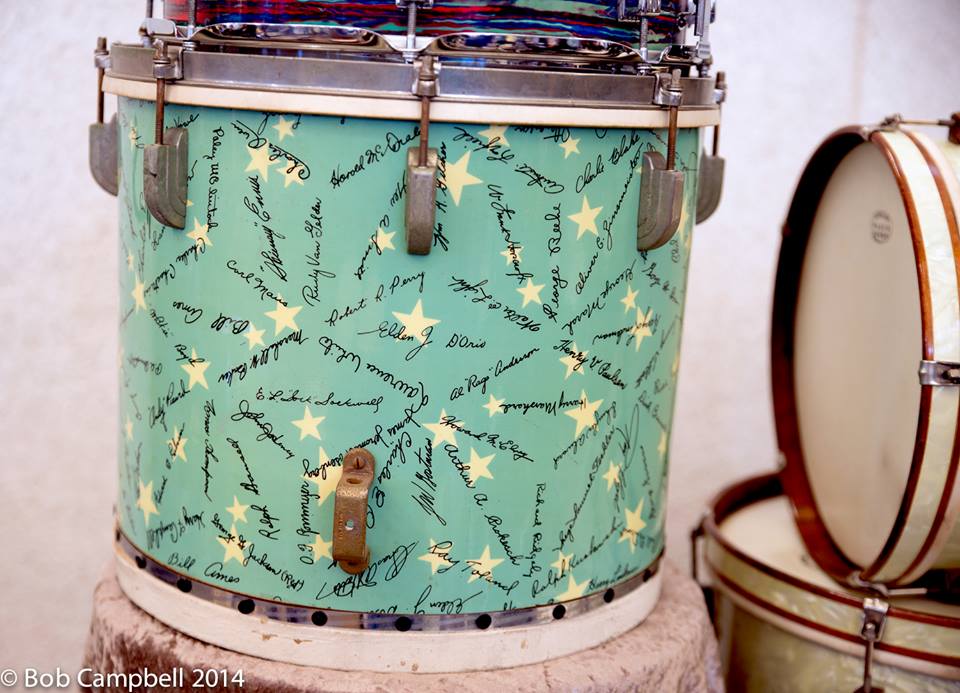
This year, the two days were jam-packed with great booths, performances, clinics, master classes and educational presentations. On Saturday, there were some wonderful clinics starting off with the flamboyant, fiery-red-haired Mike Semerau (“Chicago’s #1 Drum Lessons”) in the morning, followed by the multi-talented Curt Bisquera, a.k.a. “Kirkee B”, (whose credits include: Go-Go’s, Bonnie Raitt, Seal, Celine Dion, Mick Jagger, Queen Latifah, Dixie Chicks, Lionel Ritchie, Nelly Furtado, Spice Girls, and many more), and then rounded off by a gentleman from New Orleans, Stanton Moore (Galactic, Garage a Trois, Stanton Moore “Conversations” album, Stanton Moore Drum Company, the Hudson Music Groove Alchemy educational book/CD/DVD). Stanton always impresses me with his clinics; paying homage to his drumming history, humility and the constant evolution of his playing. Most of all, that man can groove.
For the drum collectors and historians, there were some terrific presentations by Rick Gier (“Dating Ludwig and Gretsch drums”) and Gary Astridge (“Ringo’s Beatle gear on the road”; “Ringo’s Beatle gear at Abbey Road”). All in all, both Rick and Gary were quite knowledgeable and approachable; I learned a lot from each of them. They have tried to set the record straight as best as possible, capturing the facts and discussing the gaps in our knowledge. I personally loved all the pics of Ringos’ kits and gold-plated Ludwig Supraphonic.
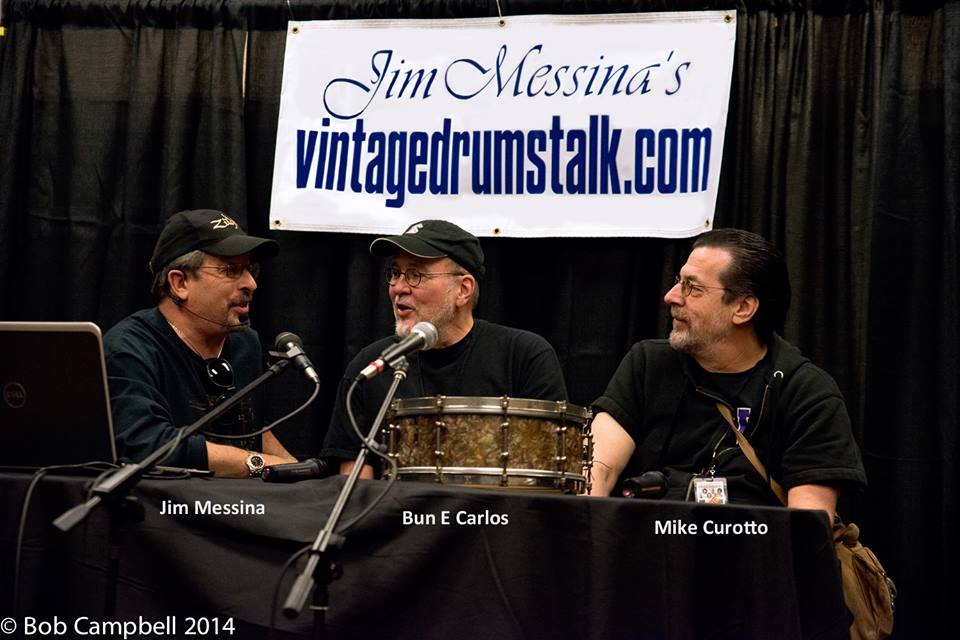
This year, the Chicago Drum Show offered a new element to the clinics and equipment - a Rebeats Roundtable in the Master Classroom on “Careers in the percussion industry” which Kat was keen to attend. The Careers roundtable featured Karl Dustman as moderator (music industry executive), and Jim Catalano (Ludwig Drum Company), Todd Trent (Ontario Music, Artists Relations for Ludwig and now Taye Drums), and Paul Wertico (Trio New, Paul Winter, seven-time Grammy Award winner with Pat Metheny Group), as panelists. So if you were thinking about getting into the business of drums/percussion, these guys were definitely great role models and sources of info. This roundtable was divided into two parts. The first segment was a 50-minute overview of the percussion industry as a whole, including everything from education to retail sales. The second segment consisted of about 50 minutes detailing how the percussion industry breaks down the economic impact of revenue generated by drum sales, services and education. One of the main features was a discussion of whether or not to pursue a higher education. Furthering your education was always viewed as a positive factor. Having a degree in Music or Business was helpful, but wasn’t the only way to get the job. Jim Catalano and Paul Wertico each had extensive education and then built on their experience in percussion. However, Todd Trent’s moving up the ladder from music store stock boy to Sales and Marketing Manager for Taye Drums proved that “plain old hard work” and lessons on the job pay off as well. While each worked diligently to get where they are today, there wasn’t any single formula for success. They did give some general advice:
- It is important not only whom you know, but also who knows you.
- Learn to market yourself and be your own best advertiser.
- Go to the shows.
- Be an active participant. Introduce yourself.
- Continue to move on forward.
To sum it all up, this was a very enlightening class offered by the Chicago Drum Show. It was refreshing to experience an educational event that didn’t actually involve a performance. One left this discussion feeling empowered. I (Kat) hope that more educational classes such as this will be offered in the future.
During both days, Jim Messina of Vintage Drums Talk (www.vintagedrumstalk.com) was doing live interviews with renowned drum experts such as Mike Curotto, Mark Cooper, Dave Brown, Bun E Carlos, Steve Maxwell and more. So that was just Saturday and I didn’t mention all the great drums yet…!



